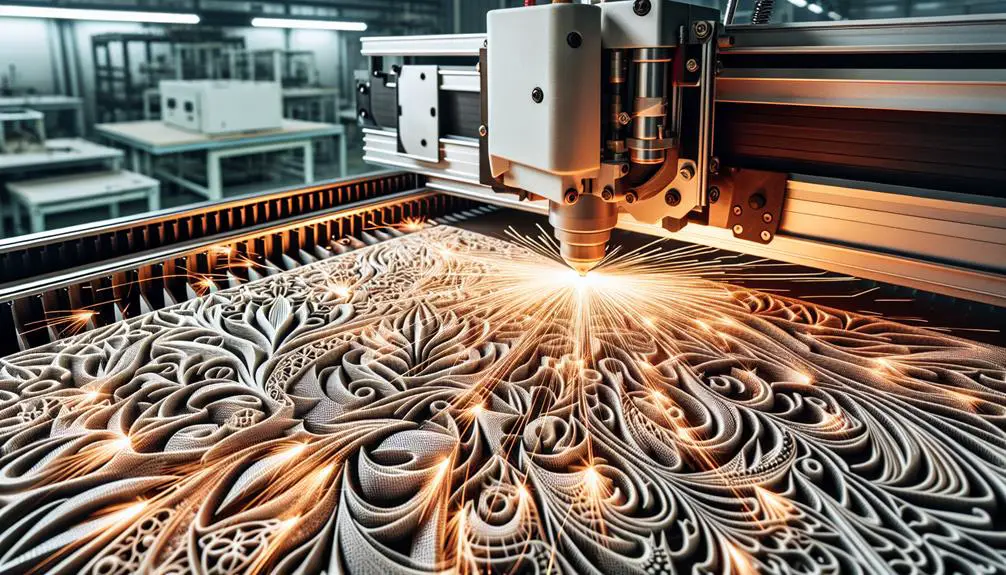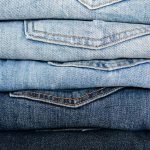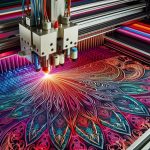When you're delving into laser cutting fabrics, understanding the technology behind it is essential. Imagine creating intricate designs with pinpoint precision, whether you're working with delicate lace or sturdy polyester. This isn't just about cutting; it's about transforming your fabric projects with the power of a focused laser beam. But before you start, you need to grasp how the machines work, the types of fabrics best suited for laser cutting, and the necessary safety measures. Ready to reveal the full potential of your fabric designs? Let's explore the key elements that make laser cutting an invaluable tool in the textile industry.
Table of Contents
Key Takeaways
- Laser cutting provides precise, intricate designs on various fabrics using computer-controlled focused laser beams.
- Compatible with both natural and synthetic fibers, offering versatility in fabric selection.
- CO2 and fiber laser cutters cater to different scales and material requirements.
- Design software like Adobe Illustrator and AutoCAD allows for detailed customization and simulation.
- Benefits include time efficiency and minimal waste, while drawbacks include potential fabric fraying and high initial equipment costs.
How Laser Cutting Works
Laser cutting operates by using a focused laser beam to precisely cut through fabric materials. You'll find that this technology offers unparalleled fabric customization, allowing you to achieve designs and patterns that were once unimaginable.
The laser beam, controlled by computer software, guarantees laser precision, providing you with clean, accurate cuts every time. This precision means you can work on intricate designs without worrying about fraying or uneven edges.
Imagine the design possibilities at your fingertips. From delicate lace patterns to complex geometric shapes, laser cutting opens up a world of creativity.
You can easily manipulate the laser settings to adjust the cutting intricacies, ensuring each piece meets your exact specifications. Whether you're crafting bespoke garments or producing high-quality home textiles, laser cutting enhances your ability to innovate and excel.
Suitable Fabrics
When choosing fabrics for laser cutting, you'll need to take into account both natural and synthetic options. Natural fibers like cotton and silk cut cleanly and produce minimal fumes.
Synthetic materials such as polyester and nylon also work well, offering precise edges and intricate designs.
Natural Fiber Options
Among the best natural fiber options for laser cutting, cotton stands out for its clean cuts and minimal fraying. Cotton isn't only a practical choice, but it's also sustainable, making it ideal for those concerned about environmental impact. Its natural fibers produce less harmful emissions during the cutting process, guaranteeing a greener approach to fabric design.
When you work with cotton, you'll appreciate its smooth texture and excellent drape, which lend themselves well to various applications from fashion to home decor. The precision of laser cutting enhances these inherent qualities, allowing for intricate designs without compromising the fabric's integrity.
Linen is another excellent natural fiber option. Known for its durability and eco-friendly attributes, linen offers a distinct texture and a crisp drape that can elevate any project. Its slightly coarse feel can add a unique tactile dimension to your designs.
Wool, with its rich texture and insulating properties, also performs well under laser cutting. It handles intricate patterns beautifully and offers a luxurious drape. Plus, wool's natural resilience guarantees that your creations maintain their structure and appearance over time.
Synthetic Material Choices
Synthetic fabrics offer a range of benefits for laser cutting, from enhanced durability to a variety of textures and finishes. When selecting synthetic materials, you'll find plenty of options that optimize both performance and aesthetic appeal. Here are some top choices to keep in mind:
- Polyester Blends: These fabrics are incredibly versatile. Polyester blends combine the strength of synthetic fibers with the soft feel of natural ones. They don't fray easily, making them perfect for intricate cuts and detailed designs.
- Nylon Options: Known for their high tensile strength and elasticity, nylon fabrics are excellent for projects requiring flexibility and durability. They resist wear and tear, providing long-lasting results without compromising on quality.
- Acrylic Fabrics: These are lightweight yet strong, offering excellent color retention. Acrylic fabrics are also resistant to mold and mildew, making them ideal for outdoor applications.
- Spandex Blends: If stretchability is essential, spandex blends are your go-to choice. These fabrics guarantee a snug fit and maintain their shape over time, ideal for activewear and form-fitting garments.
Machine Types
When selecting a laser cutting machine for fabrics, you'll want to evaluate the features of CO2 lasers, the advantages of fiber lasers, and the versatility of hybrid machines.
Each type has its own strengths that can cater to various fabric cutting needs.
Let's explore how these options can enhance your fabric cutting projects.
CO2 Laser Features
CO2 laser machines come in various types, each offering unique features tailored to different fabric cutting needs. These machines are renowned for their laser precision and ability to produce clean, intricate designs. However, to harness their full potential, you need to understand their features and guarantee laser safety.
First, let's explore the types of CO2 laser machines:
- Desktop CO2 Laser Cutters: Ideal for small-scale projects, offering excellent precision in a compact form. They're perfect for hobbyists and small businesses.
- Industrial CO2 Laser Cutters: Designed for high-volume production, these machines provide robust laser precision and are equipped with advanced safety systems.
- Hybrid CO2 Laser Cutters: These versatile machines can handle multiple materials, making them excellent for workshops that deal with various fabrics.
- Portable CO2 Laser Machines: Lightweight and mobile, these are great for on-site projects or when space is a constraint, yet they don't compromise on precision.
Each type guarantees you get the most out of your fabric cutting endeavors, but remember, laser safety is paramount. Always adhere to safety guidelines to prevent accidents. Mastering these machines requires both understanding their features and practicing safe operation.
Fiber Laser Benefits
Revealing the potential of fiber laser machines exposes significant benefits for fabric cutting applications. You'll find that the speed advantages and precision benefits set these machines apart from others. Fiber lasers operate at incredibly high speeds, allowing you to complete intricate designs and bulk orders faster than ever. Their precision is unmatched, providing clean, smooth cuts that reduce the need for post-processing and secure high-quality results.
The cost savings are another compelling factor. Fiber lasers consume less power and have fewer maintenance requirements compared to other laser types, leading to lower operational costs. Additionally, these machines boast longer lifespans, providing you with a reliable tool that won't necessitate frequent replacements.
Customization options elevate the utility of fiber lasers in fabric cutting even further. Whether you're working with delicate silks or robust denims, you can easily adjust settings to match your material, enhancing your capacity to deliver tailored solutions.
Here's a quick comparison to illustrate the fiber laser benefits:
| Benefit | Description |
|---|---|
| Speed Advantages | Faster operation, ideal for bulk and intricate cuts |
| Precision Benefits | Clean, smooth cuts, reducing post-processing |
| Cost Savings | Lower power consumption, minimal maintenance |
Harness these advantages to elevate your fabric cutting mastery.
Hybrid Machine Options
Exploring hybrid machine options unveils a versatile approach to fabric cutting that merges the best features of multiple laser types for enhanced performance. By leveraging the strengths of both CO2 and fiber lasers, hybrid machines offer unparalleled customization choices, enabling you to handle a wide array of fabrics with speed and precision. This adaptability not only boosts your efficiency but also unlocks a wealth of creative possibilities.
Here's why hybrid machines might be the ideal choice for your fabric cutting needs:
- Customization Choices: Hybrid machines allow you to switch between laser types, tailoring the cutting process to specific fabric characteristics and project requirements.
- Speed and Precision: Combining the rapid processing capabilities of fiber lasers with the intricate detailing possible with CO2 lasers guarantees that every cut is both swift and precise.
- Cost Efficiency: Investing in a hybrid machine can be more cost-effective in the long run, as it eliminates the need for multiple specialized machines, reducing both initial costs and maintenance expenses.
- Creative Opportunities: The versatility of hybrid machines broadens your creative horizons, enabling you to experiment with complex designs and unconventional materials.
Design Software
To get started with laser cutting fabrics, you'll need to choose the right design software that suits your project needs. The design process is essential because it plays a significant role in determining the quality of the final product. Software like Adobe Illustrator, CorelDRAW, and AutoCAD are popular choices that allow for intricate designs and precise cuts. Customization options within these programs enable you to tailor every detail, ensuring your fabric projects are unique and exactly as envisioned.
You must also consider fabric compatibility when selecting your design software. Different fabrics have varying material limitations, and not all software handles these differences equally well. Some programs offer specific settings for materials like cotton, polyester, and silk, which help optimize the laser cutting process. Ensuring your software can manage these settings will save you time and reduce errors.
Additionally, many design software options provide simulation features. These allow you to visualize how the laser will interact with the fabric, revealing potential issues before you start cutting. By mastering the design software, you'll streamline your workflow and achieve professional-quality results in your laser-cut fabric projects.
Benefits of Laser Cutting
Laser cutting offers unparalleled precision and versatility, making it an ideal choice for fabric projects. When you invest in a laser cutter, you're not just buying a machine; you're accessing a suite of benefits that can transform your work.
First and foremost, cost efficiency and precision cutting go hand in hand. Laser cutters minimize material waste, ensuring you get the most out of every inch of fabric. You'll achieve consistently clean cuts without the fraying edges common with traditional methods.
Moreover, the time-saving aspect is significant. Laser cutting streamlines your workflow, allowing you to complete projects faster. With automated processes, you can handle complex tasks that would otherwise be labor-intensive.
Here's why laser cutting is indispensable for fabric projects:
- Intricate Designs: Create detailed patterns that would be nearly impossible to reproduce manually.
- Consistency: Every cut is identical, ensuring uniformity across multiple pieces.
- Versatility: Suitable for various fabrics, from delicate silks to sturdy denims.
- Efficiency: Reduced material waste and faster production times lower overall costs.
Potential Drawbacks
While laser cutting offers numerous advantages, understanding its potential drawbacks is essential.
One issue you might encounter is fabric fraying. Certain materials, especially natural fibers like cotton or linen, can fray at the edges if the laser's settings aren't perfectly calibrated. This happens because the laser's heat can sometimes be insufficient to completely seal the cut edges, leaving them vulnerable to unraveling.
Another significant concern is potential burns. The intense heat generated by the laser can cause scorch marks or even burn through delicate fabrics if you're not careful. This is especially problematic with synthetic materials, which can melt quickly under high temperatures. Ensuring the laser's power and speed settings are precisely adjusted is necessary to avoid damaging your fabric.
Moreover, the initial cost of laser cutting equipment can be quite high, which might be a deterrent if you're just getting started. Additionally, there's a learning curve associated with mastering the technology. You need to invest time in understanding how different fabrics react to laser cutting to achieve best results.
Safety Measures
Securing the safe operation of laser cutting equipment is crucial to prevent accidents and fabric damage. You must adhere to essential safety precautions and meet training requirements to master the process.
Here's a concise guide to help you navigate safely:
- Training Requirements: Before operating a laser cutter, complete thorough training. This guarantees you understand the machine's functions and safety features, reducing the risk of accidents.
- Safety Precautions: Always wear appropriate protective gear, including safety goggles and gloves. Confirm the workspace is well-ventilated to avoid inhaling harmful fumes. Never leave the machine unattended while it's running.
- Hazard Prevention: Regularly inspect your equipment for any signs of wear or damage. Check that all safety interlocks and emergency stop buttons are functional. Keep flammable materials away from the laser cutter to minimize fire risks.
- Emergency Protocols: Familiarize yourself with emergency procedures. Know how to quickly shut down the machine in case of malfunction. Have a fire extinguisher within reach and guarantee everyone in the vicinity knows how to use it.
Maintenance Tips
Regular maintenance is key to maintaining your laser cutter in top condition and delivering optimal results. Start by implementing a routine cleaning schedule, which will help prevent residue buildup on the lens and mirrors. Use proper cleaning techniques by relying on gentle, non-abrasive materials.
Don't forget to store your fabrics correctly. Proper fabric storage guarantees that dust and debris don't contaminate your cutting area, resulting in clean and precise cuts.
Next, familiarize yourself with common repair methods. This will prepare you to handle minor issues without professional help, saving you time and money. Keep a toolkit with essential items like lens wipes, alignment tools, and replacement parts.
Troubleshooting tips can be a lifesaver when facing unexpected issues. Here's a quick reference table for some common problems:
| Issue | Solution |
|---|---|
| Laser not cutting cleanly | Check lens and mirrors for dirt |
| Inconsistent power | Verify power settings |
| Burning edges | Adjust speed and power levels |
| Misalignment | Realign laser path |
| Machine not starting | Inspect power connections |
Project Ideas
Now that your laser cutter is well-maintained, let's explore some engaging project ideas you can tackle with it. Laser cutting fabrics opens up a world of creativity and precision. Here are four enchanting projects to get your creative juices flowing:
- Quilt Patterns: Create intricate quilt patterns with laser precision. You can cut complex shapes and designs that would be nearly impossible by hand. It's an efficient way to guarantee all your pieces fit together perfectly, making your quilting projects stand out.
- Clothing Embellishments: Add unique touches to your garments with custom clothing embellishments. From delicate lace patterns to bold geometric shapes, laser cutting lets you personalize your wardrobe with stunning detail and accuracy.
- Home Decor: Elevate your living space with bespoke home decor items. Think laser-cut curtains, tablecloths, or even wall hangings. The precision of the laser cutter allows you to produce intricate designs that can transform any room.
- Costume Making: Whether for cosplay, theater, or Halloween, laser cutting simplifies costume making. You can create exact replicas of complex designs, ensuring your costumes are both accurate and visually appealing.
These projects not only showcase your skills but also push the boundaries of traditional fabric crafting.
Frequently Asked Questions
Can Laser Cutting Be Used on Multi-Layered Fabrics?
Yes, you can use laser cutting on multi-layered fabrics, but you'll face some laser cutting challenges. Mastering this technique in layered fabric applications requires precise control to guarantee clean cuts through all layers without damaging them.
How Do Laser-Cut Edges Affect Fabric Durability?
You might worry about edge fraying, but don't. Laser-cut edges actually seal the fabric, enhancing fabric longevity. This precision cutting method guarantees your creations stay durable and maintain their quality over time.
What Is the Environmental Impact of Laser Cutting Fabrics?
You're considering the environmental impact of laser cutting fabrics. It should be highlighted that while energy consumption is a factor, the process promotes waste reduction, aligns with sustainable practices, and offers eco-friendly options for fabric production.
Are There Any Fabric-Specific Settings for Optimal Laser Cutting?
Just as Da Vinci tailored his tools, you must adjust settings for each fabric. Fabric compatibility and cutting speed are essential. Fine-tune the laser power and speed to achieve precise cuts for different materials.
How Does Laser Cutting Compare to Traditional Cutting Methods in Terms of Precision?
You'll find laser cutting offers superior cutting accuracy and efficiency compared to traditional methods. It reduces material waste greatly, though the cost comparison may vary based on equipment expenses. Overall, laser cutting excels in precision.
- How Does Ring Spun Cotton Affect Garment Fit and Shape Retention? - August 13, 2024
- What Are the Challenges in Producing Ring Spun Cotton? - August 13, 2024
- Is Ring Spun Cotton Suitable for Plus-Size Clothing? - August 13, 2024







